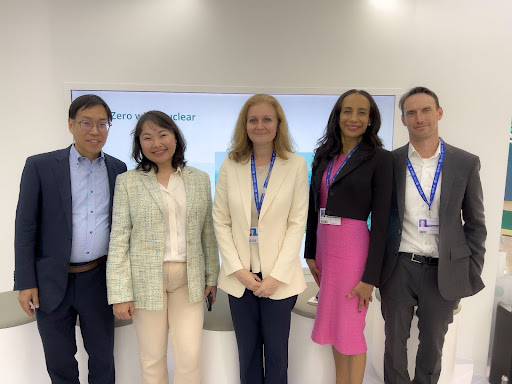DUBAI - COP28 — December 4, 2023 — The Net Zero Nuclear initiative hosted a panel, “Accelerating Climate Financing for Nuclear Innovation: ETFs, Portfolio Investment, and Climate Bonds” coordinated by Anthropocene Institute at this year’s UN climate change conference (COP28). Distinguished panel members included Charles Oppenheimer, Founder, Oppenheimer Project/Operating Partner 8090 Industries; Dail St. Claire, Independent Board Director-Nasdaq and Verde Clean Fuels; and Elina Teplinsky, Energy Industry Team Leader, Hydrogen Practice Co-Leader, Leading Member of International Nuclear Practice, Pillsbury Winthrop Shaw Pittman LLP; and Dr. Frank Ling, Chief Scientist, Anthropocene Institute. Dinara Ermakova, Ph.D., nuclear engineer and nuclear advocate, was invited to COP28 by the Net Zero Nuclear initiative as part of the young nuclear advocates delegation to moderate the panel.
About $40 billion in capital spending is invested globally on new and existing nuclear projects, in contrast to $350 billion that is spent on renewables. To accelerate the deployment of nuclear reactor designs across a range of capacities and applications, far more capital will be needed across the nuclear supply chain. The panelists presented their perspectives on the opportunities and challenges to mobilize capital.
Ling discussed the massive opportunity for nuclear investment, given the need for an additional 800 gigawatts of nuclear capacity, requiring up to $16 trillion in investment to meet that target. Added Oppenheimer, “Fission is one of the most important things we can cooperate on, and there’s an opening right now when we can rally around the idea. Nuclear doesn’t have a science problem as much as a financing and project problem.” He then advocated for public-private partnerships to catalyze investment.
When asked what has held back nuclear investment in the U.S., Teplinsky noted that the U.S. accomplishes almost everything with private funding. Outside the U.S., most countries’ nuclear industries are owned by the state. “When the government makes a decision, especially in countries that have money like China and Russia, they make a decision and put together five-, 10-, or 15-year plans and get things done,” said Teplinsky. “We need to tie technological innovation and political support and figure out how to actually implement [nuclear] in the U.S. in an intelligent and smart way.”
Ermakova asked St. Claire about environmental justice initiatives. In her 28 years of investing, including starting her career at the New York City Public Pension Fund, St. Claire has seen the scope of ESG investing grow. “E is driven by climate, nature, and biodiversity. S is very much driven by economic justice. G is about having all stakeholders at the table.” She is particularly excited about the move to include more communities and countries, including the least developed countries, in the conversation and governance of building nuclear projects.
On the financing side, St. Claire said, “On the investment spectrum, you have 100% philanthropy and 100% financial returns and percentages in between. I can tell you that even with 100% financial returns, you can also achieve the ESG matrix. There’s no question you can do both.”
When panelists were asked about attracting investment when returns on nuclear energy projects might take up to a decade, Teplinsky noted that non-traditional players like sovereign wealth funds and private equity are seriously looking at nuclear investments, largely because they are under pressure to comply with ESG standards.
Added Oppenheimer, “The UAE did an amazing job. They put all the money down and built a plant. That’s innovative. But how can we bring family office, philanthropic, catalytic, and even government money to get the next one going?” St. Claire noted the success of Prosper Africa and other innovative forms of government-sponsored, blended financing to mobilize capital and reduce the risks of investing in nuclear energy projects. Ling added that it is important to take a portfolio approach to nuclear investing by combining well-known, low-risk technologies with high-risk, high-reward ones. St. Claire doubled down on his comments, noting that donor-advised funds, where family offices and individuals can invest according to their mission-driven goals, can be part of the solution.
One big issue, said Teplinsky, is that the World Bank and other international finance institutions exclude nuclear energy for political reasons. “Why don’t we create a new bank for financing nuclear projects? Not just for reactors, but for supply chain, equipment, and factories? We need a ‘world bank’ for nuclear energy. It would catalyze trillions of dollars. This idea has been socialized with several dozen countries and nobody has said it would be a bad idea. …we’re hopeful it will become a reality.”
When asked why nuclear projects have failed in the past, the panelists agreed that most fail due to financing shortfalls, but with advances in nuclear energy technology, they believe this will change. “We should explore other options like small modular reactors and microreactors,” Ling said. “They potentially could be scaled in a much more modular fashion.”
The panelists emphasized the need to include emerging countries and take a holistic approach that factors in the impacts on individuals and communities. “In terms of financing in these regions, we need to be taking the risks off the table, like some percentage of the first loan loss,” advised St. Claire. Teplinsky added that one reason why the UAE’s nuclear project was successful is that risks were mitigated by going with proven reactor technology from Korea. “We have to think about how to band together,” she said. “The developing world can team up with countries that have project development experience.”
Concluded Ling, “At COP, there’s a lot of tension between development and decarbonization. Nuclear energy presents the opportunity for developing countries to leapfrog and go directly to a decarbonized economy while developing at the same time.”
